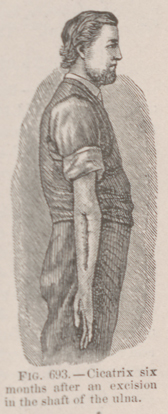Title: Boyce, W. D.
Source text: The Medical and Surgical History of the War of the Rebellion. (1861-65.), Part 2, Volume 2 (Washington, DC: Government Printing Office, 1876), 953.
Civil War Washington ID: med.d2e30896
TEI/XML: med.d2e30896.xml
CASE 1907.—Private W. D. Boyce, Co. I, 124th New York, age 37 years, was wounded before Petersburg October 27, 1864. On the following day he was admitted to the Depot Hospital of the Second Corps, at City Point, where Surgeon G. B. Parker, U. S. V., recorded: " Gunshot wound of right arm. Surgeon O. A. Judson, U. S. V., reported the wounded man's admission to Carver Hospital, Washington, October 30th, and described the injury and operation, which he performed, as follows: "Gunshot wound of right forearm, a conoidal ball entering the posterior and middle portion, producing a compound comminuted fracture of the middle third of the shaft of the ulna, and lodging in the wound. At date of admission the wounded parts were greatly swollen and slightly œdematous. The constitutional state, however, was tolerably good, but he seemed somewhat exhausted, and was suffering from anorexia. On November 1st, the patient was anæsthetized and the wound thoroughly examined, when it was thought proper that excision should be performed. Six inches of the middle portion of the shaft of the ulna was removed by a straight incision and the missile was extracted. The patient rallied promptly from the shock of the operation and continued to improve without any unfavorable complication, the wound filling rapidly with healthy granulations. Simple dressings were applied, and tonics and nourishing diet were administered. December 31st, the wound is healing rapidly. The above treatment has been continued; patient has had no unfavorable symptom. March 31st, the wound has entirely healed with loss of rotatory motion of forearm, otherwise the arm being very useful." The specimen, consisting of the excised portion of the ulna, and represented in the adjacent wood-cut (FIG. 692), was contributed to the Museum by the operator. The patient was discharged from service April 13, 1865, and pensioned. Examiner J. Nichols, of Washington, D. C., April 20, 1865, certified: " * * Great deformity. Limb entirely useless for even light labor. It is an impediment to labor," etc. Examiner J. H. Helmer, of Lockport, N. Y., certified, August 29, 1865: " * * Elbow dislocated. He cannot close his hand," etc. The Lockport Examining Board, consisting of Drs. Helmer and S. T. Clark, reported, October 11, 1873: " * * Dislocation of elbow still unreduced. * * Pronation and stipulation is destroyed. The arm is "useless, as perfectly so as if amputated at the elbow joint." The pensioner was paid September 4, 1875. A photograph, taken about the time of his discharge, and recently obtained from the Pension Bureau, is copied in the annexed cut (FIG. 693).

